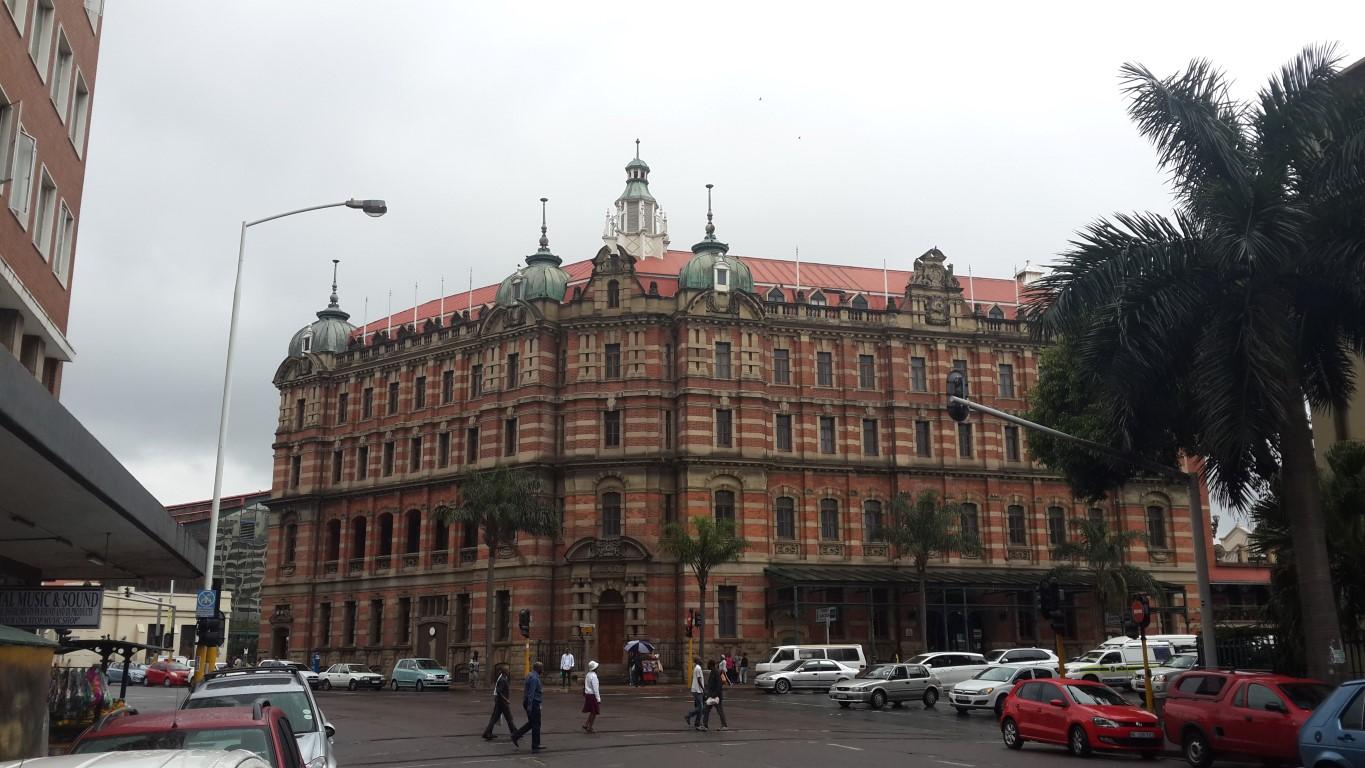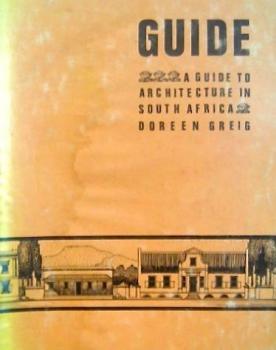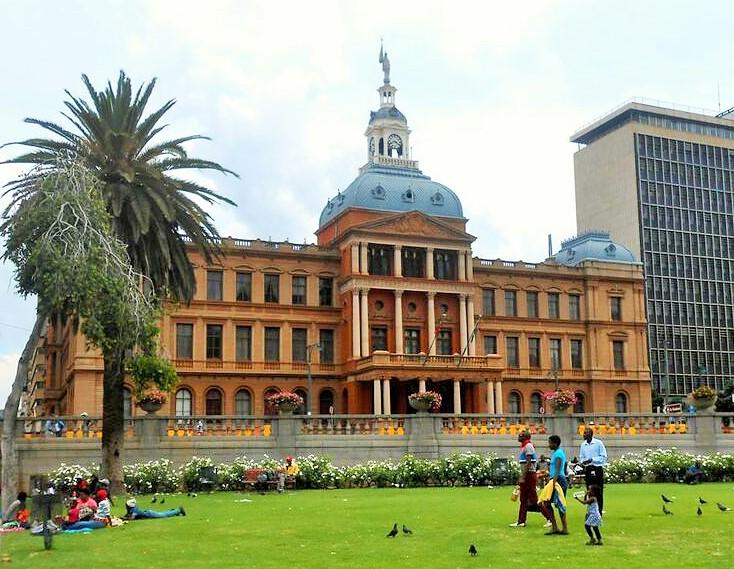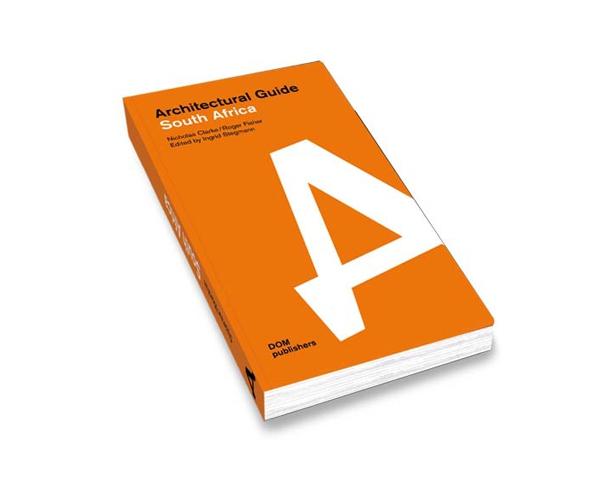
Doreen Greig's Guide to Architecture in South Africa was published more than 40 years ago by Howard Timmins, with only 1000 copies printed and, with each numbered, it speedily became a classic. The coverage was national, with not too heavy a focus on the well trodden Cape Dutch genre. Yet to view this book today one realizes how far architectural writing and books about architecture have come. The illustrative photographs were small and filled with dark shadows. Yet Greig was an authority and her grasp of her subject was sure. Confident judgements and opinions were based on life long study and practice. Greig was the great authority on historical architecture in her time and wrote the impressive book on Herbert Baker.
The first part of the book comprised a series of seven essays which takes the history of South African architecture at a gallop. The second part of the book is a catalogue or inventory of South African buildings aimed to illustrate architectural achievement in each town, city or place mentioned. The survey of buildings is an expression of personal choice and preference. Greig wanted to capture the buildings which she thought noteworthy, enduring or interesting. There is some cross referencing back to Part 1 where particular buildings stand as examples of historical trends and types.
Since Greig's time architectural analysis and criticism has become more analytical, broader and now moves beyond the older mental and geographical boundaries of apartheid and colonial constraints. Today new international and African comparisons infuse commentary. New fashions in architecture and post modernist thinking sets different yardsticks. Nonetheless, the Greig volume is an essential cornerstone of architectural history and is still a valuable work or reference. It is the reference one turns to as a starting point and one almost automatically asks of a particular building, "Did Greig say anything about this one?”. Like Pevsner her work is a classic and a forerunner of later scholarship.
2015 Price Guide: R450-R600
Munro Stars: **** (four stars) for erudition
Book Cover
Architectural Guide South Africa, Roger Fisher, Nicholas J Clarke, edited by Ingrid Stegmann contributions by Ilze Wolff, Nina Saunders, Mo Phala and Melinda Silverman. Dom are publishers in Berlin, whose tag line is "books made by architects". They produce a series of professional looking, cheerful city and country architectural guides around the world. Their architectural guide to South Africa is a new venture and is the model of a successful combination of international design, technical sophistication, quality photography and local expertise. The guide is meant to be a practical navigation tool for the visitor, the tourist, and the South African heritage enthusiast.
The design from the bright orange, stiff board flexible cover to the colour coding, from nifty shape to practical maps, from easily read two column text to the hold-in-your-hand, easy shape make this the definitive 174 page new guide to pop into your airplane carry-on bag. It is one in a world wide series and having found Dom publishers, I shall be on the look out at airport bookstores for other of their city and country guides. Clearly this is the Lonely Planet for architectural enthusiasts and buffs.
The technical sophistication lies in the use of QR codes for each entry. The code contains ego data for reading and scanning by an iPhone to set your location and direction for the next building on your itinerary.
The guide is replete with dozens of quality colour photographs. Each building has been photographed and the size of the photos varies from small icon to double page spreads making for visual appeal. A map of South Africa together with a map for each of the four leading cities gives easy cross referencing to numbered place and the QR code.
The authors, Nicholas Clarke and Roger Fisher, present the guide and set the context with an introductory essay around seven socio architectural themes and a further seven typological themes explain the character and history of the three metropoles, Cape Town, Durban and the Johannesburg - Pretoria axis. The emphasis is on the urban and the assumption is that most overseas visitors are city explorers. Chronology, legacy and architectural movements are opened up in a brief sharp focus to promote a quick understanding of who and what matters in the built environment.
Local experts, all architects, then tackle the task of introducing "their city". Ilsa Wolff, known for her passion to preserve a modernist heritage, introduces 42 buildings to illustrate "My Cape Town”. Space, place and social mobility are themes which she uses to reveal a multiplicity of Cape towns through structures such as a slave lodge, parliament, university campus, banks and businesses, galleries, hotels, civic edifices, provincial buildings, airport, stadium, convention centre. Each edifice is named, located, dated, numbered and attributed to an architect. It is deft, neat and appealing.
Nina Saunders who has made her professional architectural career with projects for democratization and inner city rejuvenation in Kwa-Zulu Natal, introduces "My Durban" in 42 structures which she considers insightful and significant starting with the Old Durban Station complex. Her selection includes a mix of public and institutional, business and residential, markets and temples, beach frivolities and serious harbour working buildings, convention centres and sports stadia. Overall her aim is to capture the essence of old and new Durban and in this she succeeds. Who would have thought that a sanitation pump centre is as important as a new international airport in catching a sense of place.
Mo Phala introduces Pretoria as the jacaranda city in 27 iconic thumbnail sketches of the obvious candidates (Union buildings, Raadsaal, Voortrekker Monument, the City Hall, the State Theatre) and the not so familiar (Protea Towers, the Agrivaal building, and the BRT Stations). Using this listing as a guide the city will romp one through South African history and the history of styles. The emphasis is on the layering of work, architects’ ideas and visions and changing values in the capital city. Phala loves the city, but is perhaps too much of an insider to present the city as the nation's capital. What is it that knits this historic city together with its blend of Afrikaner traditionalism and excessively showy state sponsored modernity?
Raadsaal Pretoria (The Heritage Portal)
The "My Johannesburg" of Melinda Silverman is a city of gold but she moves beyond the clichéd and identifies 35 buildings worth exploring and talking about, from the Old Park Station of Klinkhamer to Leith's Johannesburg Station masterpiece, from Astor Mansions to Innes Chambers, from the Central Police station to the Soweto Theatre, from Rand Club to the Mandela Bridge. Again it's a mix of styles, functionalities, architects and eras. Not all entries carry an explanatory text which is a negative. There are some surprising omissions, no Ponte, no Johannesburg hospital, no Anglo American building, no Anglican or Catholic Cathedrals, no Civic Theatre or Civic Centre and only the Convention Centre from Sandton (and it's Sandton not Stanton as on the map). So plenty of space for another list if you are a tour guide.
Innes Chambers (Brian McKechnie)
This book is an important addition to urban architectural literature and a great little introduction to some of the best of South African architecture (though some would say also some horrors included). Personal taste and choice of the contributors is evident but this is to be expected. The real challenge is to express the spirit of the city as a unique place and for me the Durban chapter wins that competition. I don't know how easy it would be to use the guide as a route planner; it will probably work better for Cape Town and Durban than for Johannesburg and Pretoria. There is still another guide to be written to the architecture of the towns and villages of the country.
2015 Price Guide: R350-400 in print and obtainable from Exclusive books, Amazon or Clarke's Bookshop
Munro Stars: **** (four stars) for innovation
Book Cover (Dom Publishers)
Give me Greig for arm chair travel and let me take the Fisher and Clarke group with me for moving about and discovering the cities of South Africa!
Kathy Munro is an Honorary Associate Professor in the School of Architecture and Planning at the University of the Witwatersrand. She enjoyed a long career as an academic and in management at Wits University. She trained as an economic historian. She is an enthusiastic book person and has built her own somewhat eclectic book collection over 40 years. Her interests cover Africana, Johannesburg history, history, art history, travel, business and banking histories.
Munro Stars
***** A superb book, top reference source, recommended to the highest degree and has influenced me in some significant way.
**** A very good book, a worthy reference or an excellent read
*** Good effort and contains much of interest... the expected norm for a book
** Some merit, keeping in the library but not overly impressed
* Awful book not worth keeping



